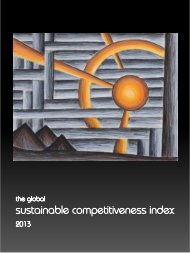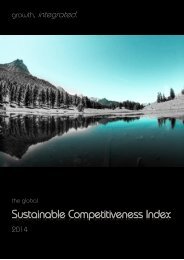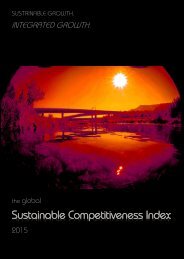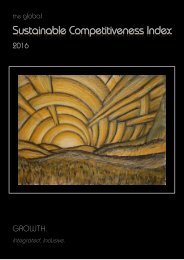The Global Sustainable Competitiveness Index 2019
Measuring competitiveness comprehensively: Sweden & Scandinavia tops, Germany #15, UK 17, US 34, China 37 in the Global Sustainable COmpetitiveness Index 2019
Measuring competitiveness comprehensively:
Sweden & Scandinavia tops, Germany #15, UK 17, US 34, China 37 in the Global Sustainable COmpetitiveness Index 2019
Create successful ePaper yourself
Turn your PDF publications into a flip-book with our unique Google optimized e-Paper software.
Resource Intensity
Table of
Contents
Resource Management World Map
The Resource Management Sub-Index is composed of indicators scored relative
to population (e.g. GHG per capita) as well as relative to economic output (e.g.
energy consumption per GDP). Indicators measured against population (per
capita) clearly favour countries with low resource and raw material consumption
(i.e. less developed countries), while indicators scored relative to GDP measure
economic efficiency.
The resource intensity map shows that the resource intensity of less developed
countries seems to be – generally speaking - lower than that of higher developed
economies. However, indicators are measured both against economic output
(GNI/GDP) and against per-capita performance. While the per-capita intensity
is naturally lower in less developed economies, the per-output performance in
efficient developed countries is lower than in the developing countries.
The resource intensity ranking is topped by Kenya, followed by Togo and Ethiopia
– mainly due to low resource consumption. However, also highly developed
economies achieve high rankings – Sweden (5), Luxembourg (6) and the UK (8)
are all ranked within the top ten. However, the World’s economic powerhouses
are ranked significantly lower – Germany on 77, Japan on 96, the US on 102, and
China on 160. The low rankings indicate a distinctive potential for improving
sustainable competitiveness through reducing resource intensity and resource
management – i.e. reducing costs, at the end of the day.
The main implications of higher or lower resource management capabilities are
related to stability and sustained economic growth: should global prices for raw
materials and energy rise significantly in the future (as trends and the majority of
available research suggests), the countries in the lower ranks will face substantial
higher costs and challenges to maintain their growth compared to countries with
higher efficiency and intensity scores.
The Resource Intensity World Map. Dark areas indicate low, light areas indicate high resource Intensity.
22








